Picking out new tile for your kitchen, bathroom or other space can be rather exciting. It’s easy to get caught up in looking at tile samples and the various colors, materials and patterns that are going to have a big impact in your home. But what often gets overlooked or downplayed is the selection of the grout color. And that shouldn’t be the case.
The color of your grout can make or break the look of your tile. The grout color can create different effects or visually blend away. To help you choose the right grout color for your tile scheme, here are some favorite looks you might want to consider, along with some general advice for virtually every tiling scenario you might encounter.
The color of your grout can make or break the look of your tile. The grout color can create different effects or visually blend away. To help you choose the right grout color for your tile scheme, here are some favorite looks you might want to consider, along with some general advice for virtually every tiling scenario you might encounter.
When white or very light tile is paired with a matching white or almost-white grout, the lines between tiles visually disappear and the entire surface blends together. The result is a look that doesn’t tend to draw attention.
For this reason, this pairing is perfect when you don’t want your tile to be a feature, especially in modern spaces that already have dramatic flair elsewhere.
Find a bathroom designer near you in the Houzz pro directory
For this reason, this pairing is perfect when you don’t want your tile to be a feature, especially in modern spaces that already have dramatic flair elsewhere.
Find a bathroom designer near you in the Houzz pro directory
This combo is also great for a small bathroom you want to make look as large as possible.
Shop for Tile
Item 1 of 4
By keeping the walls light and seamless looking, you avoid visual breaks that could shrink your perception of the space, so the room feels big and breezy.
Keep in mind that a truly white or very light grout will not be forgiving when it comes to stains or discolorations, so it may take a little extra care or upkeep to maintain that pristine look.
See how to clean grout
See how to clean grout
White Tile + Gray Grout
Once you start to add a little contrast between your tile and your grout, the shape of the tile is revealed much more clearly, and the grout itself forms a pattern out of the negative space.
Once you start to add a little contrast between your tile and your grout, the shape of the tile is revealed much more clearly, and the grout itself forms a pattern out of the negative space.
Going darker or lighter with the grout, to add more or less contrast, will make the tile pop more and more.
A soft gray just a few shades darker than the tile is a popular choice because it highlights a tile pattern without shouting for attention. This is especially true for tiles in which the shape, rather than a color or print, is the main feature, such as the charming fish scale shown here.
A soft gray just a few shades darker than the tile is a popular choice because it highlights a tile pattern without shouting for attention. This is especially true for tiles in which the shape, rather than a color or print, is the main feature, such as the charming fish scale shown here.
It’s also useful for calling attention to an interesting layout of tiles in a plain shape, such as classic subway tile laid in a herringbone. The carefully selected pattern is emphasized by the grout, so the extra effort on installation doesn’t go to waste.
Even in a simple brick pattern, a soft gray grout paired with white tile makes for a solid choice for traditional or transitional spaces. It brings a level of subtle richness that suits Shaker cabinets, veined stone counters, warm wood floors and other sumptuous finishes — and it’s timeless too.
White Tile + Black or Dark Grout
Once you start to go very dark with your grout, the grout itself and the patterns it creates start to become the visual focus over the actual tile.
Once you start to go very dark with your grout, the grout itself and the patterns it creates start to become the visual focus over the actual tile.
Notice how much more pronounced this herringbone pattern appears than the earlier similar-patterned example. The diagonally stepping stripes formed between tiles really pop and give a lot of energy and life to the space.
Browse more bathroom inspiration
Browse more bathroom inspiration
Naturally, this high-contrast tile scheme is well suited to spaces in which black and white is the dominant look. It also works for industrial kitchens that eschew bold hues in exchange for metallic elements and rugged textures. The grout already brings a lot of architectural interest, so sparing use of accent colors will keep the space from feeling overloaded.
Black Tile
Keep in mind that when you’re dealing with black or very dark tile, the previous rules essentially are reversed.
Keep in mind that when you’re dealing with black or very dark tile, the previous rules essentially are reversed.
Dark grout in a similar tone to a dark tile will create a softer look, while a light grout will bring out the tile pattern, adding even more drama. If you like black tile but want to soften the look, choose a charcoal shade for the tile and match it closely, rather than choosing a pure black and trying to soften it with white. The look will only be more vivid. (Alternatively, you can add a beautiful rug, as shown in this welcoming bathroom.)
Colorful Grout
If you like the look of grout that pops but don’t want it to be as stark as black and white, consider using a tinted grout that carries a fun hue instead of the usual gray shades. This lemon yellow grout adds a twist of color to this bathroom, but it doesn’t visually advance too much, so the room stills looks big and bright.
If you like the look of grout that pops but don’t want it to be as stark as black and white, consider using a tinted grout that carries a fun hue instead of the usual gray shades. This lemon yellow grout adds a twist of color to this bathroom, but it doesn’t visually advance too much, so the room stills looks big and bright.
Colorful grout works especially well when it picks up a hue that is found elsewhere in the space, so it feels harmonious to the palette instead of coming out of nowhere. It’s definitely not for everyone, but for those who want a unique look, it can add a lot of personality. Just keep in mind that your grout is not nearly as easy to replace as a coat of paint, so you’ll want to be sure to pick a color you truly love and not a fleeting trend.
See how to regrout your tile
See how to regrout your tile
Like the idea of colorful grout but not the commitment? Try using a patterned wallpaper that echoes the shapes of a tile pattern and use a more basic scheme for the actual tiles themselves. This is a smart approach for a home you plan to leave in the short term. The next occupants can simply change the paper if they don’t share your tastes.
Shop for Wallpaper
Item 1 of 5
Colorful Tile + Gray Grout
Once you move away from stark white or black, pairing vibrant-colored tile with the right shade of grout becomes a bit trickier. It is harder to tell what grout will contrast the tile or blend in. It’s important to look at the color still as having a value — darkness or lightness — that is separate from the intensity of the hue itself.
Once you move away from stark white or black, pairing vibrant-colored tile with the right shade of grout becomes a bit trickier. It is harder to tell what grout will contrast the tile or blend in. It’s important to look at the color still as having a value — darkness or lightness — that is separate from the intensity of the hue itself.
One trick that can help you assess the color value of your tile is to take a photo of the tile and use a program or app to make the image black and white (often referred to as a “saturation” or “desaturate” option). Once you take the hue out of the equation, you can really see how light or dark the color is and choose a grout that will either contrast with or match that level of value to get the result you want.
Choosing a gray grout that is close in value to the tile will allow the grout to fade into the background, which creates an uninterrupted color statement. Going a little lighter or darker will subtly highlight the grout a bit more to bring out the pattern, but it won’t create as much contrast as with white tile.
Get more kitchen ideas
Get more kitchen ideas
Colorful Tile + White or Light Grout
Using a white or very light grout with a vivid tile may sound dramatic, but it actually helps to tame wild colors and give the space a cleaner, more timeless feel. There is a reason you so often see bright reds paired with crisp white. It’s because it helps make the color livable.
Using a white or very light grout with a vivid tile may sound dramatic, but it actually helps to tame wild colors and give the space a cleaner, more timeless feel. There is a reason you so often see bright reds paired with crisp white. It’s because it helps make the color livable.
Colorful Tile + Colorful Grout
If you’re already adding colorful tile, why not add colorful grout to go with it? A pairing like this cool blue and vibrant yellow feels bold and exotic, bringing a bit of international hotel appeal without much added cost.
If you’re already adding colorful tile, why not add colorful grout to go with it? A pairing like this cool blue and vibrant yellow feels bold and exotic, bringing a bit of international hotel appeal without much added cost.
Other Design Considerations
Besides the tile color and shade, there are other factors that can affect how the look of your grout will turn out.
Surrounding colors and materials. Here’s an example in which a colorfully tinted grout doesn’t actually feel nearly as bold as in previous examples. The rosy undertones of this grout pick up on the tones of the surrounding wood, so they actually blend in rather than pop.
Besides the tile color and shade, there are other factors that can affect how the look of your grout will turn out.
Surrounding colors and materials. Here’s an example in which a colorfully tinted grout doesn’t actually feel nearly as bold as in previous examples. The rosy undertones of this grout pick up on the tones of the surrounding wood, so they actually blend in rather than pop.
Using a bit of a red or brown tint in your grout can work well to coordinate with nearby materials like brick, wood, leather or stone, so make sure to consider all the nearby finishes and not just the tile itself.
Your designer or contractor can usually give you swatches of the grout just like with paint or other materials, so you can put all of your finishes and samples together in one place and see how they look together.
Find a kitchen and bathroom designer near you
Your designer or contractor can usually give you swatches of the grout just like with paint or other materials, so you can put all of your finishes and samples together in one place and see how they look together.
Find a kitchen and bathroom designer near you
Wall versus floor. Where the tile is situated will affect how much the grout reads. A tile that’s dressing the floor will be literally less “in your face” than a tile that’s up at eye level on a wall, so you can bring a little more contrast to your grout. This floor tile is paired with a light grout, but the pattern still feels fairly subtle down on the floor. In general, the floor is a good place to bring some rich contrast to anchor the space.
Tile edges. Ceramic tiles can be “rectified” or “non-rectified,” which essentially means “crisp edged” or “natural edged.” The non-rectified tiles in this space give the grout lines a less crisp shape, which gives this black grout the appearance of almost hand-drawn lines, as though the space were a sketch brought to life. Non-rectified tiles can’t get as close together as rectified tiles, meaning there is a limit to how thin your grout lines can be, which brings me to my next point.
Porcelain vs. Ceramic Tile: A 5-Scenario Showdown
Porcelain vs. Ceramic Tile: A 5-Scenario Showdown
Grout size. The thickness of the grout is almost as important to the look as the color, as it can make the grout stand out or disappear almost completely if you choose a wider or tighter tile spacing. For example, this slab tile has extremely thin grout in a color matched to the tile, so the grout lines virtually disappear and the finish appears like a continuous swath of solid luxe stone.
Tile shape will also affect the grout sizing at times, especially with circular forms like this penny tile. The larger areas of grout between the adjacent curves mean the grout will appear bolder than it might with a square or rectilinear tile, so it’s best to choose a shade a bit closer to the tile than you might think.
Tile finish. Glossy tiles like a high-sheen porcelain or a bright mirror tile will catch highlights and often appear lighter on the wall than they may look in your hand when holding a sample. For these materials, go with a lighter grout than you might otherwise choose.
Notice in this case how the patterning of the tile is revealed by the cabinet lights even without a bold grout.
Notice in this case how the patterning of the tile is revealed by the cabinet lights even without a bold grout.
An exception to this tip would be tinted and antiqued mirror tiles or mirror tiles used in a room with many dark finishes. In those cases, bring a grout swatch into the room and see if it matches the general colors in the space. After all, the appearance of the mirror will depend on what it is reflecting. Ultimately, a very tight spacing between the tiles with minimal grout will be best, so the color needn’t be a perfect match to every conceivable tone.
Multiple tiled surfaces. When working with two tile patterns in the same space, which is quite common in bathrooms with tiled floors and walls, the ideal solution is to find a grout shade that will work across the board for a harmonious look.
This can mean bringing a dark shade from the floor up the walls, or using a light shade all over, depending on your preference. But you’ll want to look at the tiles together to make a choice that suits each. If no grout seems to work for both tiles, you may want to take that as a sign that you need to reconsider your tile pairing.
Ultimately, while it may seem almost too obvious, using a classic mid-tone gray all over is usually a safe bet to tie multiple tiles together, while having some leeway to hide imperfections as the grout ages.
Multicolored tile. Lastly, it can seem tricky to pick a single grout color when your tile is multicolored, but it can actually be even easier to find an attractive pairing. One approach is to choose a single color or shade within the tile set to match — usually the most neutral one you can find. If you copy a color already in the tiles, you know it will coordinate.
Another option is to choose a grout shade light enough or dark enough to contrast all of the tiles, which works well if all of the tones in the tile are in a middle range without extreme lights and darks.
In this example from one of my projects, the off-white grout is light enough to stand out a little bit from all of these soft greige shades and ties the traditional tile back to the contemporary white cabinets.
In this example from one of my projects, the off-white grout is light enough to stand out a little bit from all of these soft greige shades and ties the traditional tile back to the contemporary white cabinets.
For patterned tile, usually the best bet is to choose a color that will blend into the tiles as much as possible so as to not interrupt the pattern. Look to the edges of the tile to see what color will be up against the tile the most. In this floor tile, the black is what stands out to the eye, but the white portions are more toward the edges of the tile, so a light grout is the more effective choice — a dark grout would chop the pattern up too much.
Finally, with a veined stone tile, you can either choose a shade that matches the base color of the stone or a shade that brings out the veins. In this bathroom, the light grout emphasizes the individual tile, highlighting the edges of each tile, which can otherwise get lost among the organic patterning.
For a more subtle effect, choose a color from the lightest veins in the stone. This will gently emphasize the subtle tones while letting the character of the stone be the focus over the grout. If you’re splurging on marble, it’s the marble you want to see.
Source: Houzz.com





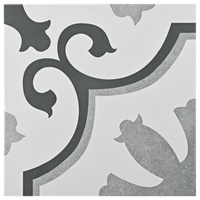
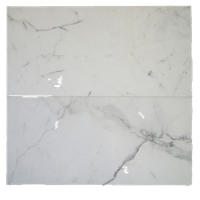














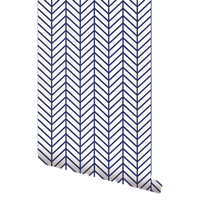
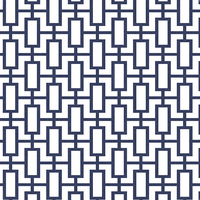
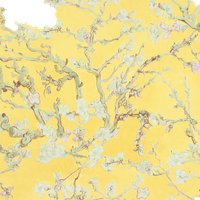


























When you look at this bathroom, your eye may first notice any number of things, but it’s likely not going to be the tile.